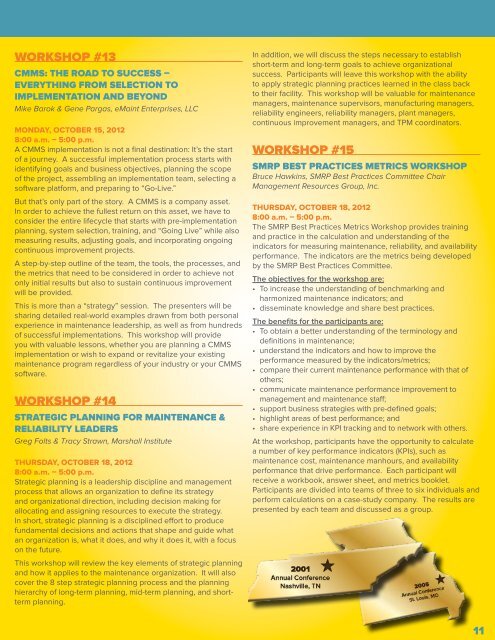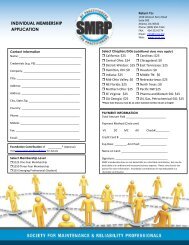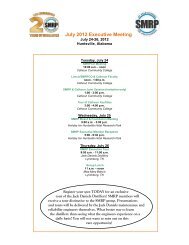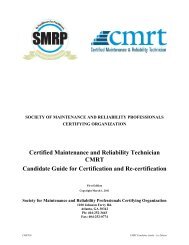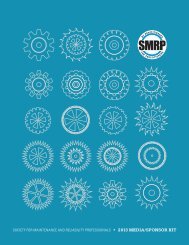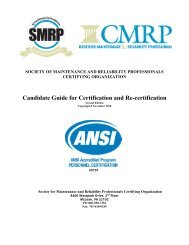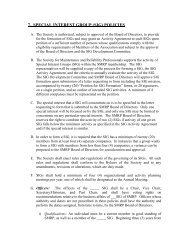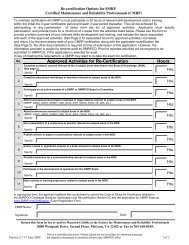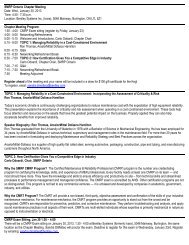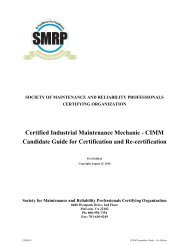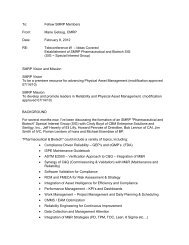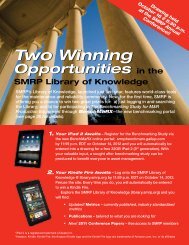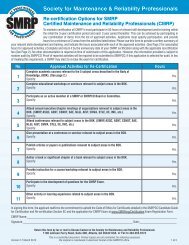conference brochure - Society for Maintenance & Reliability ...
conference brochure - Society for Maintenance & Reliability ...
conference brochure - Society for Maintenance & Reliability ...
- No tags were found...
You also want an ePaper? Increase the reach of your titles
YUMPU automatically turns print PDFs into web optimized ePapers that Google loves.
Workshop #13CMMS: The Road to Success –Everything from Selection toImplementation and BeyondMike Barok & Gene Pargas, eMaint Enterprises, LLCMonday, October 15, 20128:00 a.m. – 5:00 p.m.A CMMS implementation is not a final destination: It’s the startof a journey. A successful implementation process starts withidentifying goals and business objectives, planning the scopeof the project, assembling an implementation team, selecting asoftware plat<strong>for</strong>m, and preparing to “Go-Live.”But that’s only part of the story. A CMMS is a company asset.In order to achieve the fullest return on this asset, we have toconsider the entire lifecycle that starts with pre-implementationplanning, system selection, training, and “Going Live” while alsomeasuring results, adjusting goals, and incorporating ongoingcontinuous improvement projects.A step-by-step outline of the team, the tools, the processes, andthe metrics that need to be considered in order to achieve notonly initial results but also to sustain continuous improvementwill be provided.This is more than a “strategy” session. The presenters will besharing detailed real-world examples drawn from both personalexperience in maintenance leadership, as well as from hundredsof successful implementations. This workshop will provideyou with valuable lessons, whether you are planning a CMMSimplementation or wish to expand or revitalize your existingmaintenance program regardless of your industry or your CMMSsoftware.Workshop #14Strategic Planning <strong>for</strong> <strong>Maintenance</strong> &<strong>Reliability</strong> LeadersGreg Folts & Tracy Strawn, Marshall InstituteThursday, October 18, 20128:00 a.m. – 5:00 p.m.Strategic planning is a leadership discipline and managementprocess that allows an organization to define its strategyand organizational direction, including decision making <strong>for</strong>allocating and assigning resources to execute the strategy.In short, strategic planning is a disciplined ef<strong>for</strong>t to producefundamental decisions and actions that shape and guide whatan organization is, what it does, and why it does it, with a focuson the future.This workshop will review the key elements of strategic planningand how it applies to the maintenance organization. It will alsocover the 8 step strategic planning process and the planninghierarchy of long-term planning, mid-term planning, and shorttermplanning.In addition, we will discuss the steps necessary to establishshort-term and long-term goals to achieve organizationalsuccess. Participants will leave this workshop with the abilityto apply strategic planning practices learned in the class backto their facility. This workshop will be valuable <strong>for</strong> maintenancemanagers, maintenance supervisors, manufacturing managers,reliability engineers, reliability managers, plant managers,continuous improvement managers, and TPM coordinators.Workshop #15SMRP Best Practices Metrics WorkshopBruce Hawkins, SMRP Best Practices Committee ChairManagement Resources Group, Inc.Thursday, October 18, 20128:00 a.m. – 5:00 p.m.The SMRP Best Practices Metrics Workshop provides trainingand practice in the calculation and understanding of theindicators <strong>for</strong> measuring maintenance, reliability, and availabilityper<strong>for</strong>mance. The indicators are the metrics being developedby the SMRP Best Practices Committee.The objectives <strong>for</strong> the workshop are:• To increase the understanding of benchmarking andharmonized maintenance indicators; and• disseminate knowledge and share best practices.The benefits <strong>for</strong> the participants are:• To obtain a better understanding of the terminology anddefinitions in maintenance;• understand the indicators and how to improve theper<strong>for</strong>mance measured by the indicators/metrics;• compare their current maintenance per<strong>for</strong>mance with that ofothers;• communicate maintenance per<strong>for</strong>mance improvement tomanagement and maintenance staff;• support business strategies with pre-defined goals;• highlight areas of best per<strong>for</strong>mance; and• share experience in KPI tracking and to network with others.At the workshop, participants have the opportunity to calculatea number of key per<strong>for</strong>mance indicators (KPIs), such asmaintenance cost, maintenance manhours, and availabilityper<strong>for</strong>mance that drive per<strong>for</strong>mance. Each participant willreceive a workbook, answer sheet, and metrics booklet.Participants are divided into teams of three to six individuals andper<strong>for</strong>m calculations on a case-study company. The results arepresented by each team and discussed as a group.11


